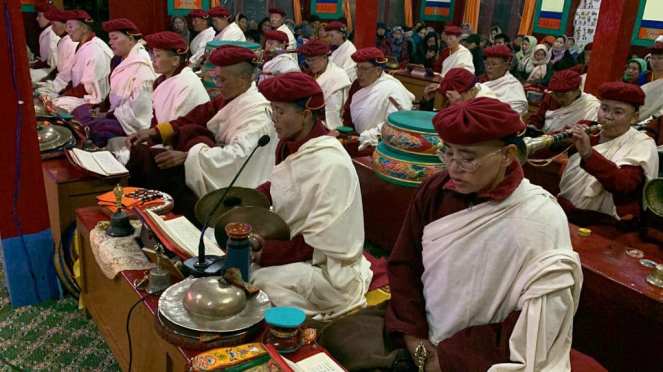“Inner heat (tummo) keeps the warmth of great bliss that leads oneself directly into the great spaciousness of one’s own realisation (Great liberation). We actually don’t know how to put these experiences in words because this is beyond imagination and explanation.”–12th Gyalwang Drugpa (January 2024)
Yesterday, 26th January 2024, the 12th Gyalwang Drugpa Kagyu head posted some stunning photos and videos on Facebook of Drugpa Kagyu nun yoginis who are practising the tummo (inner heat), 24 hours per day, in the icy-cold and remote regions of Ladakh. He wrote:
“Tsangpa Gyare’s later years were largely occupied with teaching. Sometimes he stayed a few years in one place, but much of the time he toured the central parts of Tibet at the request of abbots and others. In about the middle of the decade of the 1190’s he founded Longdol Hermitage (klong rdol rei khrod), said to have been located not far from Lhasa, but further south along the banks of the Kyichu River (skyid chu). After a few years the community had increased to about five hundred. A sign of his increasing public stature, he was asked to mediate between warring parties at Nyetang Monastery (snye thang). He also established Shedrub Chokhor Ling (bshad grub chos ‘khor gling), in 1193.
In 1205 Tsangpa Gyare founded Druk Monastery (‘brug dgon), the monastery that gave the Drukpa its name, and there he gave a series of public empowerments. It was said that half the population of Tibet’s central province was present. Still, despite or because of all the increasing public activity, he continued to seek the solitude of remote retreat places. He also sent many of his students into long-term retreats. They say they filled the entire range of the Himalayas and beyond, covering a distance as far as a vulture could fly in eighteen days.
When Tsangpa Gyare died, his body was cremated, and many miracles were reported: his heart and tongue came out of the fire without being burned, and many crystalline relics called ringsel were also found. His vertebrae turned into twenty-one images of Avalokiteśvara, and some of these have been preserved even today. Two his disciples are known as founders of two sub-lineages of the Drukpa school. One is the Upper Druk (stod ‘brug), founded by Gotsangpa Gonpo Dorje (rgod tshang pa mgon po rdo rje, 1189-1258). The other is the Lower Druk (smad ‘brug), founded by Lorepa Wangchuk Tsondru (lo ras pa dbang phyug brtson ‘grus, 1187-1250).”
In any case, although the Drugpa Kagyu have been severely suppressed and bullied for centuries by the ruling forces Tibet, these photos and videos are testament to the resilience of the Drugpa Kagyu, in particular their yogic traditions with female practitioners at the forefront. The Gyalwang Drugpa has become well-known for supporting Drugpa Kagyu nuns, in the form of Kung Fu exercise in particular. He also shared some delightful video of the yoginis singing and dancing spiritual songs, see here.
In that respect, we can all rejoice at seeing these precious images and songs of an ancient lineage as practised by females (something, if I may dare say, the Gelugpas have no tradition of whatsoever, being predominantly focused on male monasteries and Geshes until very recently).
Music? Long-Life prayer for the Gyalwang Drugpa composed by the 4th Gyalwang Drugpa Pema Karpo and chanted by Drugpa Kagyu nuns and Girl on Fire by Alicia Keys.





